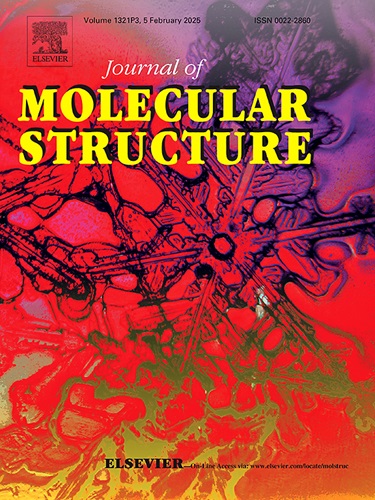Structural evolution and magnetic, optical, and optoelectronic properties changes in annealed Co0.5Sr0.5Fe2O4 nanoparticles: A comprehensive study
IF 4.7
2区 化学
Q2 CHEMISTRY, PHYSICAL
引用次数: 0
Abstract
A sample of Co0.5Sr0.5Fe2O4 nanoparticles was synthesized by the coprecipitation technique to explore the effect of annealing on the structure and some physical properties of the produced material. The coprecipitated sample consists of an orthorhombic strontium carbonate phase and the required cubic Co0.5Sr0.5Fe2O4. Annealing at elevated temperatures (900 °C) leads to the formation of cubic and hexagonal phases. This crystal structure was confirmed by X-ray diffraction analysis (XRD). The accuracy of the cation distribution of the cubic phase determined from the Rietveld analysis of XRD patterns is demonstrated by matching the experimental and theoretical lattice constants. There are several noticeable changes in aspects as the annealing temperature goes up. The transmission electron microscopy (TEM) images indicated that heating substantially affects the growth and densification of the smaller nanoparticles. There is a drop in the longitudinal and transverse wave velocities, bulk, rigidity, Young's moduli, Poisson ratio (σ), and Debye temperature (θD) with annealing and grain growth. The saturation magnetization and coercive field are enhanced with annealing. The particle size distribution calculated from TEM is confirmed and supported by the switching field distribution. The indirect optical bandgap energy (Eg) decreased with annealing. The present study concentrated on the thermal treatment impacts on various optical parameters, such as the refractive index and extinction coefficient. The optoelectrical parameters, such as the dielectric constant, dielectric loss, and optical and electrical conductivity, were extensively investigated, giving valuable insights, and their results were interpreted. These findings suggest potential applications in magnetic storage, sensors, and optoelectronics fields.
退火 Co0.5Sr0.5Fe2O4 纳米粒子的结构演变及磁学、光学和光电特性变化:综合研究
通过共沉淀技术合成了 Co0.5Sr0.5Fe2O4 纳米粒子样品,以探索退火对所制材料的结构和某些物理性质的影响。共沉淀样品由正方体碳酸锶相和所需的立方体 Co0.5Sr0.5Fe2O4 组成。在高温(900 °C)下退火会形成立方和六方相。X 射线衍射分析(XRD)证实了这种晶体结构。通过对 XRD 图样进行里特维尔德分析,确定了立方相的阳离子分布,实验晶格常数与理论晶格常数相匹配,这证明了立方相阳离子分布的准确性。随着退火温度的升高,各方面都发生了一些明显的变化。透射电子显微镜(TEM)图像表明,加热对较小纳米粒子的生长和致密化有很大影响。随着退火和晶粒生长,纵向和横向波速、体积、刚度、杨氏模量、泊松比(σ)和德拜温度(θD)都有所下降。饱和磁化和矫顽力场随着退火而增强。由 TEM 计算得出的粒度分布得到了开关场分布的证实和支持。间接光学带隙能(Eg)随退火而降低。本研究的重点是热处理对折射率和消光系数等各种光学参数的影响。此外,还对介电常数、介电损耗、光导率和电导率等光电参数进行了广泛研究,并对其结果进行了解释。这些研究结果表明,它在磁存储、传感器和光电领域具有潜在的应用前景。
本文章由计算机程序翻译,如有差异,请以英文原文为准。
求助全文
约1分钟内获得全文
求助全文
来源期刊

Journal of Molecular Structure
化学-物理化学
CiteScore
7.10
自引率
15.80%
发文量
2384
审稿时长
45 days
期刊介绍:
The Journal of Molecular Structure is dedicated to the publication of full-length articles and review papers, providing important new structural information on all types of chemical species including:
• Stable and unstable molecules in all types of environments (vapour, molecular beam, liquid, solution, liquid crystal, solid state, matrix-isolated, surface-absorbed etc.)
• Chemical intermediates
• Molecules in excited states
• Biological molecules
• Polymers.
The methods used may include any combination of spectroscopic and non-spectroscopic techniques, for example:
• Infrared spectroscopy (mid, far, near)
• Raman spectroscopy and non-linear Raman methods (CARS, etc.)
• Electronic absorption spectroscopy
• Optical rotatory dispersion and circular dichroism
• Fluorescence and phosphorescence techniques
• Electron spectroscopies (PES, XPS), EXAFS, etc.
• Microwave spectroscopy
• Electron diffraction
• NMR and ESR spectroscopies
• Mössbauer spectroscopy
• X-ray crystallography
• Charge Density Analyses
• Computational Studies (supplementing experimental methods)
We encourage publications combining theoretical and experimental approaches. The structural insights gained by the studies should be correlated with the properties, activity and/ or reactivity of the molecule under investigation and the relevance of this molecule and its implications should be discussed.
 求助内容:
求助内容: 应助结果提醒方式:
应助结果提醒方式:


